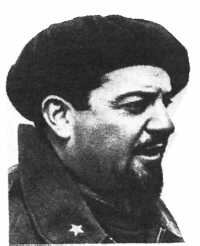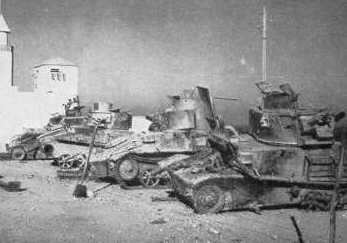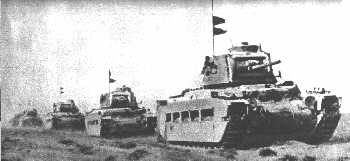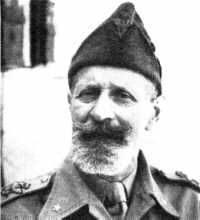![]()
![]()
![]()
![]()

![]()
![]()
Since the war outbreak it was clear that Africa should have been the only direct fighting place for Italy and UK. In particular, it was further clear that the game was going to be played in North Africa, where the Italian Libya was squeezed between French Tunisia and British Egypt.
On June 1, 1940 it was estimated that the Italian troops in the area were less than 50% of the French-British ones. The Italians, however, re-gained the supremacy when, as everybody knows, the French (regular) army suddenly evaporated following the home front events.
The pretended Italian supremacy at the war outbreak is a story which the Anglo-Saxons (including highly reputed historians) like very much ... probably because it makes their lightning advance of December 1941 more impressive and tickles the British military pride.
But let's talk about the "supremacy" concept...
At the war outbreak the Italian troopers were
actually much more than the British (average 5:1 ratio). The real problem was, however,
the quality of the respective armament , quality and quantity of supplies, and logistic
organization (had one had it!).
In terms of armored vehicles, the Italians deployed 339 L3 light tanks, 8 (eight!) Fiat 3000, and 7 (seven!) armored cars. The British opposed 134 Light Mk VI tanks, 114 A10 (Mk II) heavy cruiser tanks, and 38
armoured cars (mainly Lanchester and Morris).
 |
North Africa Phase 1 (June 12, 1940 - February 12, 1941) On June 12, 1940 the 11th Hussars Regiment "invaded Libya", by crossing the barbed wire maze (five feet high, 11 feet deep, more than 650 km long!) originally placed by the Italians at the Egyptian/Libyan border to block the desert raiders (the true ones!) |
On June 16, 1940 the first tank combat : a motorized Italian column, escorted by 17 light tanks, is engaged by British armoured cars and tanks. All our "iron soap-boxes" were either destroyed or captured ! Col. D'Avanzo (first Gold Medal awarded in Africa during WWII) died in action.
The most honest comment on the very first days of war is that addressed by Maresciallo Italo Balbo, Governor of Libya, to Gen. Badoglio, Italian General Chief of Staff :
 |
"... the only British division currently deployed has 360 between armoured cars and medium tanks. There is no match for rifles and machine-guns, we will not, however, cease to fight and will make miracles; but had I been the British commander I'd already been in Tobruk..." |
A few days later (June 20, 1940) the Governor sent another message to the High Command :
"Our assault tanks are old and, being armed with a sole machine-gun, they are already obsolete: the British machine-guns mounted on their armoured cars riddle them with bullets which fly across the thin armor of our tanks; we don't have armoured cars, the anti-tank guns are usually old and non effective, the new ones lack adequate ammunition. Thus the combat becomes a sort of meat-against-iron-fighting..."
As promised, the Italians made actual the "miracle-making" strategy and, by "creating" original, even extravagant, anti-tank vehicles (e.g. : alpine troops guns 65/17mm mounted on trucks, 20 mm anti-aircraft MG mounted on captured Morris armoured cars..) they were able to relieve their first and second lines from the British pressure .
On June 28, 1940 Balbo's airplane was shot down by "friend fire" in the skies over Tobruk ... (finally Badoglio had no longer the burden of receiving those boring and defeatist messages from the former Governor of Libya !)
| On July 1, 1940 Maresciallo Graziani was appointed Governor and received from Mussolini the same type of instructions which had been already given to the duke of Aosta in East Africa ("... our target is a limited advance, not further than Marsa Matruh. Then stop and wait for the definitive -and near to come- defeat of the British army.) Graziani, accordingly, started a complete reorganization of the Italian army, a reorganization which included the opportunity of deploying the new tanks, the secret arm which could get rid of the British heavy cruisers |  |
|
(Badoglio telegraphed : " I have seen the tanks. They are magnificent !) ... could you imagine ?!?The Italian General Chief of Staff, the highest military rank, was talking of less than one hundred M11/39, an indifferent 11 ton, badly armoured and poorly armed medium tank. The seventy M 11/39 sent to Libya were not a match for the heavy cruisers. The first time, however, they saw action (August 5, 1940), they had a better chance with the Mark VI light tanks. |
![]()
At the end of the summer of 1940, while Mussolini, willing to show the regime's muscles (sic !), was pushing on Graziani for an immediate offensive against the British troops, the Italian Governor was instead doubtful about it, fearing the possible disruptive effects of the poor training and of the "erratic" logistic organization of his troops.
He was (obviously) right and the Duce (as in many other cases) was taking a wrong decision !
But Mussolini made
clear that "maybe he was not always right...but he was always the
boss!" and, therefore, on September 8 Graziani moved
across the Egyptian border. The Italian armored warfare included more than 300
tanks (about 230 L3-type light tanks and 70 medium M11/39).
On the other side of the border, the British deployed the 7th Armoured Division organized
in three Fusileers Regiments, the 11th Hussars Regiment (armoured cars), and one squadron
of the 1st Tank Regiment.
As the numerical supremacy was with the Italians, the British troops retreated for about
50 miles.
On September 17, 1940 the Italians took over the Sidi-el-Barrani camp but,
as the feared logistic and organizational deficiencies became actual, stopped their
advance.
![]()
As the Italian advance had had a bitter taste in Churchill's mouth, the British Commander in Chief in Egypt, Gen. Wavell, quickly received a massive supply of modern materials, including 152 new tanks (50 of which were the heavy infantry tanks Matilda II), anti-tank and Bofors anti-aircraft guns, machine-guns and ammunition. Wavell immediately planned a counter-offensive but, due to the October 1940 Italian invasion of Greece, he had to divert to the Balkanian frontline a good portion of his air force.
The British revenge in North Africa had, therefore, to be postponed.
During the next two months the British Corps underwent a hard drill program, including long lasting day and night displacements, back and forth in the desert, focused to a fast 5-days raid (the "Operation Compass").
At the beginning of December 1940, the British had gained the supremacy in terms of armoured warfare as the 7th Armoured Division deployed 495 vehicles :
The Italian Armour Brigade in the Sidi-el-Barrani area consisted of 275 vehicles:
Elsewhere in Libya there were, still under fitting-out, the first new M13/40 medium tanks.
![]()
Operation Compass
 |
During the night between December 8 and 9, 1940 the British surrounded Sidi el-Barrani with their tanks. At 7:00 am the British artillery began a heavy bombardment. Gen. Maletti, one of the base Commanders, moved then his mixed tank batallion (two tank companies : one of L3, one of M11/39) to withstand the British heavy tanks. |
The result of the combat was the complete destruction of the Italian tank batallion, as the 37 mm shells could just scratch, without piercing, the thick armor of the British Matildas. Gen. Maletti was killed in action by a British machine-gunner. In the afternoon there was another tank combat around the Alam el-Tummar stronghold : the all-L3 Italian armoured unit was completely swept out.
On December 10, 1940 Sidi el-Barrani was in the hands of Gen. O'Connor while the remnants of the Italian 10th Army Corps retreated to Sollum and Sidi Omar.
![]()
| As the offensive was a such a great success, Gen.Wavell,
urged by Gen. O'Connor, agreed to continue the advance. By the end of December 1940, in spite of the Italian Air Force bombing raids which created serious problems to the British tanks, the O'Connor's 4th Armoured Brigade and 7th Armoured Division took Sollum, Sidi Omar and Ridotta Capuzzo, the Italian strong points on the Libyan border, but could not prevent Gen. Bergonzoli and his troops (which included one M13/40 tank company : 12 tanks) from withdrawing into the Bardia fortress, few miles eastwards. |
 |
The attack to Bardia was carried out by the 6th Australian infantry division, supported by the 7th Royal Tank Regiment (7th RTR) and, on a second line, by the 7th Armoured Division.
The action started at 7:30am of January 3, 1941, when the Australian troopers cut the barbed wire entanglements with their bangalore and let 22 Matilda heavy tanks to enter within the defensive perimeter. The 12 Italian M13/40 medium tanks, and few L3 light tanks, supported by anti-tank weaponry, moved against the British tanks but the Matildas' armour was invulnerable to the 47mm shells. Once again the Italian tankers had to pay a terrible tribute of blood and tears to the poor quality of their armament.
On January 5, 1941 the Bardia fortress was taken by the British who made a terrific booty : 32.000 prisoners, about 450 guns, 700 lorries, and 127 tanks.
![]()
On the subsequent day the British troops were besieging the Italian outposts near Tobruk. The Italian armoured warfare in the area comprised :
| The final attack started at 8:00am of January 21, 1941 and was
conducted in the same way as in Bardia (Australian infantry troopers supported by the
heavy infantry tanks). Although the Matildas were reduced to 16 units, they
outclassed all the Italian tanks, both the light and the medium ones. Twenty-four hours later, on January 22, 1941, the first battle of Tobruk was over. O'Connor, encouraged by the campaign progress, moved forwards his divisions aiming to Benghazi. The British forces followed two routes : one along the coast (direction : Derna, Cirene, Barce), the other straight through the desert. This latter led the British units (two armoured brigades with not less than four tank and one armoured car regiments) to a close encounter with the Italian armoured brigade in El-Mechili. |

|
The combat was carried out in two phases : during the first the Italian brigade (with 57 M-type and 25 L-type tanks) got rid of the light MkVIs (10 hit, of which 7 destroyed); during the second phase it was the turn of the Italian M13s to become the target of the heavy infantry and cruiser tanks (8 tanks hit and destroyed).
![]()
The last tank battle of the campaign was that fought in Beda Fomm
between February 5 and 7, 1941. In this location, south of Benghazi, the already mentioned
two British armoured brigades clashed with a second Italian armoured brigade (about 100 M13
medium tanks).
At the end of three days of furious combats, the British heavy tanks disposed of all the
Italian tanks.
Apart from the poor quality of the armament (armour and gun) which had made the Matildas and the Valentines practically invulnerable for the M13s, the Italian armored units were disrupted because they failed to adopt the en-masse deployment strategy, burning hundreds of crews in short range combats conducted by small groups of tanks destined to one fate only : destruction !
![]()
Once again, a long line of burnt-out hulks, while proved the dramatic incompetence of the Italian High Command and the cynism of a regime which had sent thousands of soldiers to fight (and to die) armed only with the Duce's bombastic slogans, proved also the courage and the abnegation of the Italian tankers, who always accepted to risk (and quite often to lose) their lives in hundreds of hopeless missions.
![]()
On February 12, 1941 the winning march of the British armoured corps stopped in El-Agheila. It had been a remarkable cavalcade which had kicked-off, in less than four months, the Italians from the Cyrenaica ... but the Fate was planning a nasty trick on the British hopes.

on the same day, in Tripoli, a "certain" German general was starting to warm the engines of the Afrika Korps panzers. More than one was going to know his name : Rommel
![]()
... but this is another story and will be treated in another page !
![]()
![]() Back to Klisura 69
homepage
Back to Klisura 69
homepage
![]()
![]() I'd be delighted if you filled one page of my Guestbook
I'd be delighted if you filled one page of my Guestbook
![]()
Page established on : December 22, 1997
Last update : January 28, 1998
This page is maintained by Mario Paesani .....the webmaster !
This page hosted by ![]() Get your own Free
Home Page
Get your own Free
Home Page